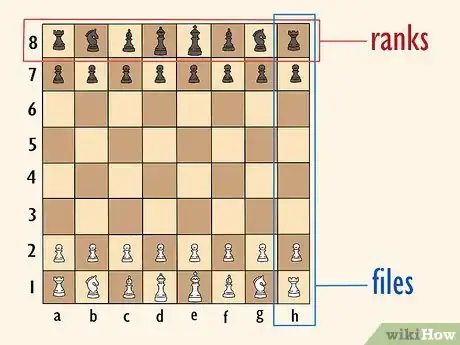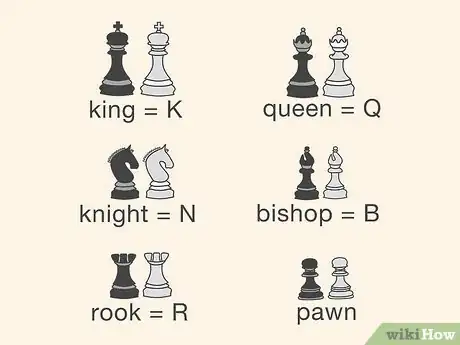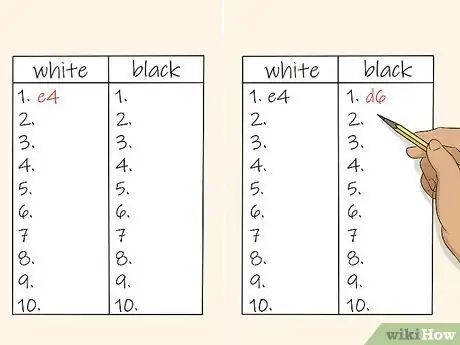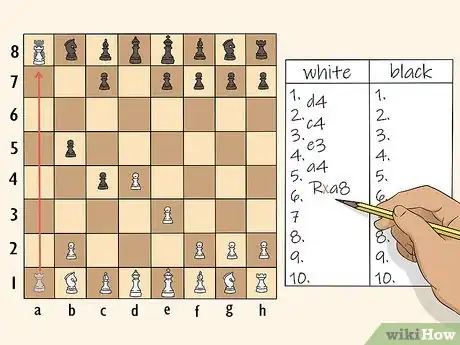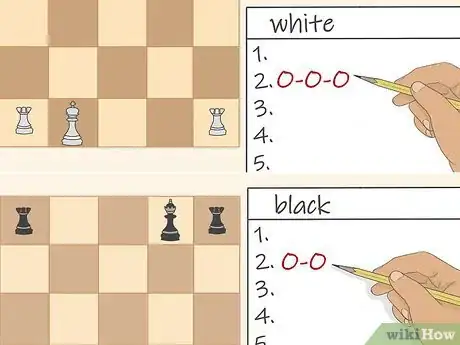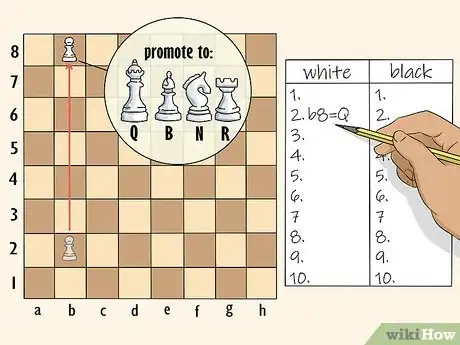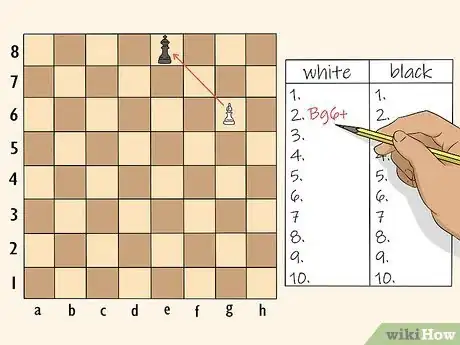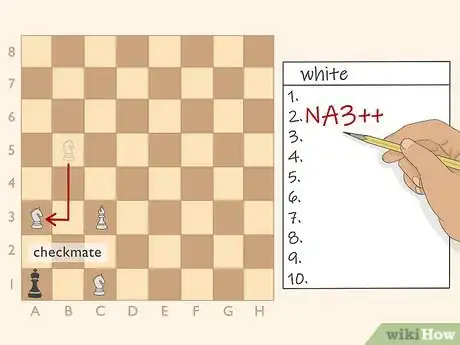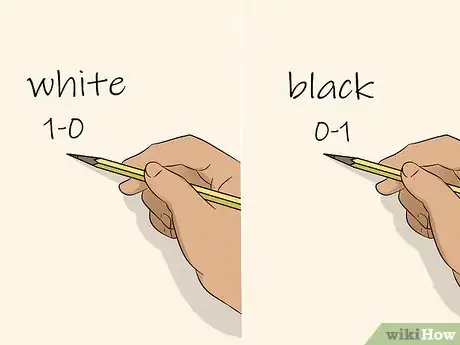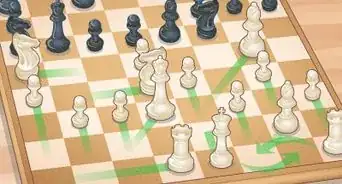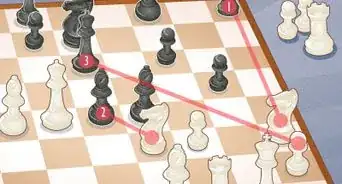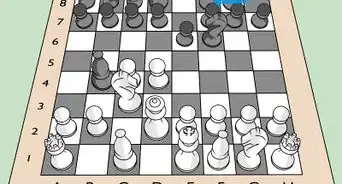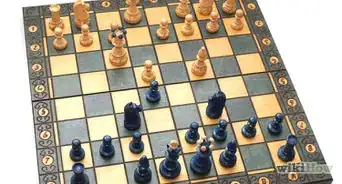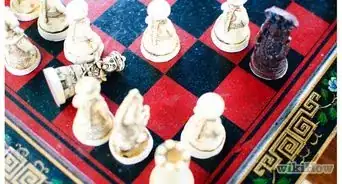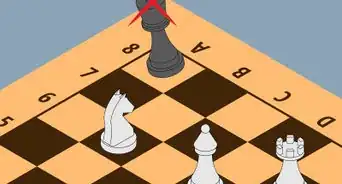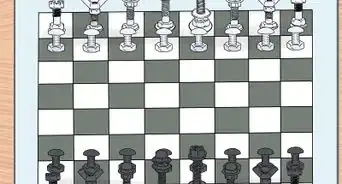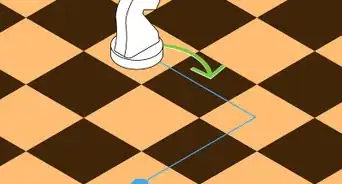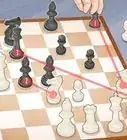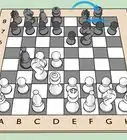This article was co-authored by Sahaj Grover and by wikiHow staff writer, Hunter Rising. Sahaj Grover is a Chess Grandmaster, World Champion, and coach, who attained his Grandmaster title at the age of 16. He has been a World Junior Bronze Medalist, World U10 Champion, South African Open 2017 & 2018 Champion, and the Winner of the Arnold Classic 2018 & 2019. Sahaj is known for dynamic attacking skills and being an excellent endgame player.
This article has been viewed 33,477 times.
Notation makes it easy to keep track of moves throughout a game of chess so you can study from them later on. If you want to learn how to notate chess, first start by learning how to list the pieces and squares so you can write down how the pieces move. If you capture pieces or perform other special moves on the board, make sure you notate them as well so someone else can read it easily. With a little bit of practice, you’ll be able to notate games and learn how to play better!
Steps
Writing Basic Algebraic Notation
-
1Familiarize yourself with the ranks and files. Ranks are the horizontal rows on the board while files are the vertical rows. The ranks are labeled 1–8, where rank 1 is the back row of white pieces and rank 8 is the back row of black pieces. The files are labeled with letters a–h, starting with the leftmost column on the white side. When you list where a piece is on the board, start with the letter of the file followed by the number of the rank.[1]
- For example, the white player’s queen always starts on the square d1 and the black player’s queen starts on d8.
- Files are only listed from left to right in alphabetical order from the white player’s perspective. If you’re the white player, then the leftmost file will be the a-file and the rightmost will be the h (and vice versa for black).
- Always write the letter of the file in lowercase.
-
2Learn the letters symbolizing each piece. Chess notation also lists which piece moves so you know exactly how it’s laid out on the board. Always write the symbols for the pieces with uppercase letters so you don’t confuse them with the files of the board. The symbols for each chess piece are:[2]
- King: K
- Queen: Q
- Knight: N
- Bishop: B
- Rook: R
- Pawns: (none)
Did you know? In international events where players and spectators may not speak the same language figurine notation is often used as notation is dependent on the language. Like the name says, figurine notation uses figurines of the pieces to signify them. You may find figurine notation here and there.
Advertisement -
3Write down the piece's symbol and the square where the piece is now. When a move is played, put the letter symbol for the piece in the notation first (or none for pawns). Without adding a space, write down the file and rank of the square where the piece ends its movement. You do not need to include the file and rank for the square where the piece started the turn.[3]
- For example, if you move your queen to the square in the 4th rank and the e-file, write down Qd4 for your notation. In this example, Q represents the queen, d refers to the vertical file, and 4 indicates the horizontal rank. It does not matter which square the queen started.
- When you move a pawn, just write down the file and rank of the square where it moves. For example, if you move the pawn on the e-file onto the 3rd rank, you would write e3.
- If two of the same piece could have made the same move, list the file or rank of where the piece was before it was moved (or both in rare cases). For example, if you have a rook at h1 and another rook at a1, write down Rhe1 so you know the rook in the h-file was the one that moved to the e1 square.
-
4List the white player’s move before the black player’s move. Since the white player always starts a game of chess, their moves are always listed first in notation. Label the turn “1.” followed by the white player’s move. Put 1–2 spaces after the notation before listing the black player’s opening move. Start a new line on your notation sheet or piece of paper after each black move to keep your notation organized.[4]
- For example, the first turn’s notation may read “1. e4 d6,” meaning the white player moved a pawn and the black player both moved pawns.
EXPERT TIPSahaj Grover is a Chess Grandmaster, World Champion, and coach, who attained his Grandmaster title at the age of 16. He has been a World Junior Bronze Medalist, World U10 Champion, South African Open 2017 & 2018 Champion, and the Winner of the Arnold Classic 2018 & 2019. Sahaj is known for dynamic attacking skills and being an excellent endgame player.Chess Grandmaster
 Sahaj Grover
Sahaj Grover
Chess GrandmasterNot sure why you should notate your game? According to Chess Grandmaster Sahaj Grover: "It's important to record your moves because otherwise, there's no provision to know what your position is. If someone bumps the table and the pieces fall off, it's just your word against your opponent's word on what the position actually was. But if you have a notation pad, it tells you exactly which moves you played and which position you're at.
Notating Special Moves in Algebraic Notation
-
1Put an “x” after the piece’s symbol to indicate a capture. If you move onto the same space as one of your opponent’s pieces, remove it from the board and place your piece there. Write down the letter symbol for the piece that you moved followed by an “x” to show that you captured a piece. Then list the square where your piece ended its move.[5]
- For pawn captures, write the file the pawn started on, followed by an "x" and the square the pawn is on. For instance, exf3 would mean that a pawn on e2 took a piece on f3.
- For example, if you used your rook to capture a piece in the 7th rank on the e file, you would write Rxe7, where R represents the rook, x indicates a capture, and e7 is the square where the rook ended its movement.
- You do not need to list the symbol for the piece you captured.
- Write en passant captures the same as any other pawn capture.
-
2Write “0-0” or “0-0-0” if you castle on the kingside or queenside respectively. Castling refers to moving your king two squares horizontally toward one of your rooks, and then placing the closest rook on the opposite side of the king. If you castle kingside (sometimes known as castling short as the rook only moves two squares), then write “0-0” in your notation. If you castle queenside (sometimes known as castling long), then use “0-0-0” instead.[6]
- You do not need to include the ranks or files in your notation.
-
3Include “=” and a piece’s symbol if a pawn gets promoted. If you’re able to get one of your pawns to the other side of the chessboard, then you can promote it to any piece besides a pawn or king. After the standard file and rank of the square, add “=” followed by the symbol of the piece you to promote the pawn to.[7]
- For example, if a player moved their pawn into the 8th rank in the b file and chose to promote it to a queen, you would write b8=Q. In this example, b8 refers to the square in the b file in the 8th rank, and =Q refers to changing the piece to a queen.
Tip: Usually, players promote the pawn to a queen since it’s the most powerful piece though in rare cases players may "under-promote" to different pieces, often as to avoid stalemate or to utilize the knight's move (as the queen does not possess it)
-
4Add “+” to the end of the notation if you put your opponent in check. Check refers to when you move one of your pieces so it can potentially capture your opponent’s king during the next turn. Write the notation for the piece as you normally would with the symbol and square where it lands, but use a “+” to show that your opponent’s king is in danger.[8]
- For example, if your bishop moved into the 6th rank on the g file and put the opponent’s king in check, then write Bg6+ for the notation.
-
5Use “++” or “#” after the notation to signify a checkmate. Checkmate refers to when you put your opponent’s king in check and they can’t make any moves to block or escape it. If you get a checkmate, either write “++” or “#” after the regular notation to show that your opponent lost the game.[9]
- For example, if you moved your knight to the square b3 and put your opponent’s king in checkmate, use Nb3++ or Nb3# for the notation.
-
6Write 1-0 if white won or 0-1 if black won. After a player wins, write 1-0 or 0-1 to signify that the player won. If the game ended in a draw, write 1/2-1/2.
Community Q&A
-
QuestionHow do you write chess notation when you put yourself into check?
 KW HCommunity AnswerYou can't put yourself in check. Only the opponent can be in check. If the opponent is checking you, it's "+".
KW HCommunity AnswerYou can't put yourself in check. Only the opponent can be in check. If the opponent is checking you, it's "+". -
QuestionSometimes I see that when something is captured, then its current position and its captured position will be written, for example, as: Qh4xe1} But I also have seen some other cases where only captured position, for example: Rxe8?
 Community AnswerActually, both ways are correct. But the most suitable and easy way is to write like Rxe8. That way will also be easy to write it quickly.
Community AnswerActually, both ways are correct. But the most suitable and easy way is to write like Rxe8. That way will also be easy to write it quickly. -
QuestionWhy does the pawn have no notation?
 Community AnswerThat's how the rule is. One of the motivations being algebraic notation was to make it as brief and compact as possible while retaining clarity. Making pawns moves implicit removed unnecessary notation.
Community AnswerThat's how the rule is. One of the motivations being algebraic notation was to make it as brief and compact as possible while retaining clarity. Making pawns moves implicit removed unnecessary notation.
References
- ↑ http://www.chesscorner.com/tutorial/basic/notation/notate.htm
- ↑ http://chesslessons4beginners.com/additional_concepts/lesson-6-algebraic-notation.htm
- ↑ https://blog.chesshouse.com/how-to-read-and-write-algebraic-chess-notation/
- ↑ http://www.chesscorner.com/tutorial/basic/notation/notate.htm
- ↑ http://chesslessons4beginners.com/additional_concepts/lesson-6-algebraic-notation.htm
- ↑ http://chesslessons4beginners.com/additional_concepts/lesson-6-algebraic-notation.htm
- ↑ https://blog.chesshouse.com/how-to-read-and-write-algebraic-chess-notation/
- ↑ http://www.chesscorner.com/tutorial/basic/notation/notate.htm
- ↑ http://www.chesscorner.com/tutorial/basic/notation/notate.htm
